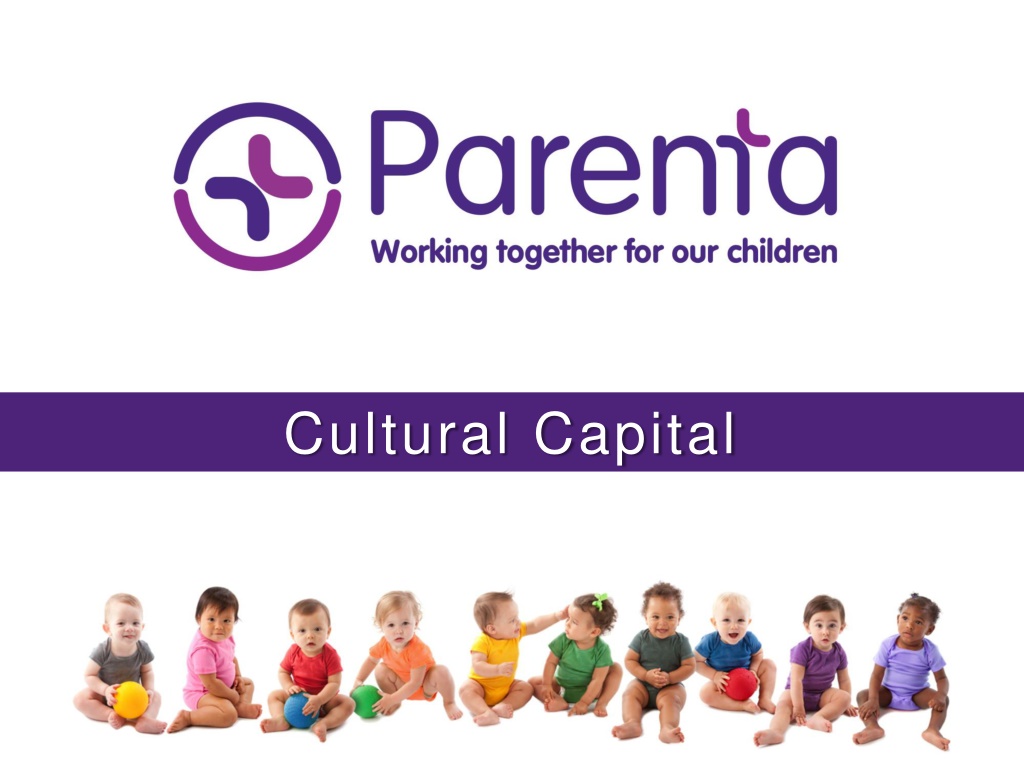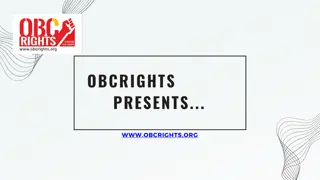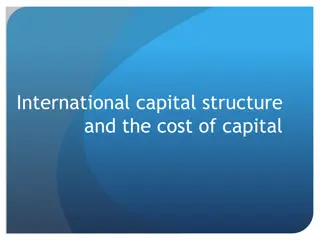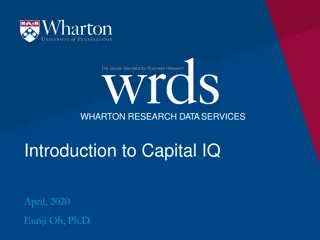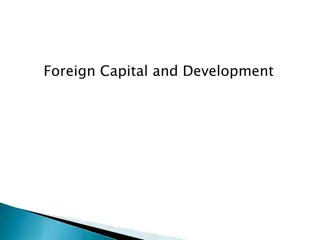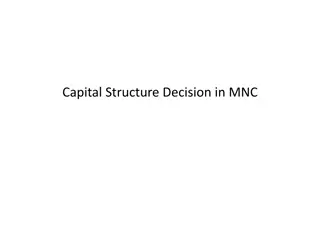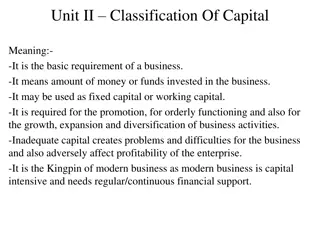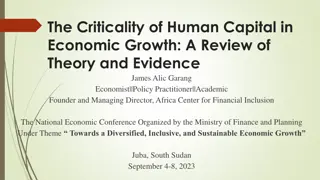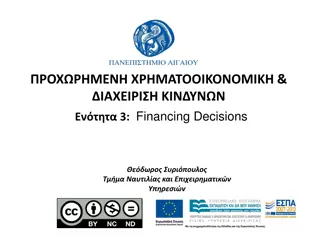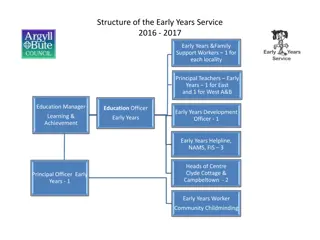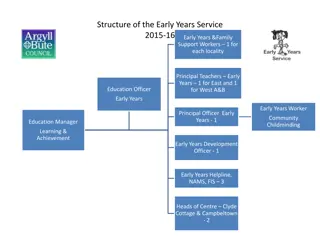Understanding Cultural Capital in Early Years Education
Cultural capital in early childhood education refers to the values, beliefs, and knowledge acquired through social class and cultural groups. Explored through the EYFS framework, it shapes children's educational experiences and outcomes. French sociologist Pierre Bourdieu emphasized its societal power dynamics, highlighting three states - embodied, objectified, and institutionalized. Reflect on your own childhood experiences to understand its impact on life chances.
Download Presentation

Please find below an Image/Link to download the presentation.
The content on the website is provided AS IS for your information and personal use only. It may not be sold, licensed, or shared on other websites without obtaining consent from the author. Download presentation by click this link. If you encounter any issues during the download, it is possible that the publisher has removed the file from their server.
E N D
Presentation Transcript
Aims/Objectives To explore what Cultural Capital looks like in an early years context and the rationale for Ofsted making reference to it in their education inspection framework To recognise where the concept of Cultural Capital is found in the early years foundation stage as children experience the awe and wonder of the world through the seven areas of learning and development. Explore the main theory behind Cultural Capital and how it has influenced Ofsted's definition Identify the concept of Cultural Capital within the EYFS Consider how practitioners can demonstrate their provision enhances children's Cultural Capital
What is Cultural Capital? Cultural capital refers to values, beliefs, norms, skills, tastes, knowledge, understandings and status that we acquire through being part of a particular social class and/ or cultural group It has been written about and explored by many writers and sociologists Ofsted says it is the 'essential knowledge that children need to be educated citizens'
Pierre Bourdieu The French Sociologist Pierre Bourdieu believed that Cultural Capital was about power in society He wrote about how society values certain values, beliefs, experiences, knowledge, more than others and these influence where individuals are placed within society and viewed by others Bourdieu describes three states of Cultural Capital
States of Cultural Capital Embodied the knowledge we acquire over time through education and being with other people Objectified the material things that we own or acquire, how we dress, the jobs we do etc... Institutionalised how cultural capital is measured or ranked, i.e. our job title, marital status, academic qualifications etc... Other forms of capital e.g. economic capital mean that we can 'buy' access to some of these things and in doing so we gain social capital
Thinking activity What are the experiences, knowledge, norms and values from your own childhood that have shaped and made an impact your life chances? Did they vary from your peers? Can you identify any gaps? What value do you place on them now?
Why are we talking about it in early years? Ofsted has introduced the term into the new Education Inspection Framework which has drawn it to the attention of the early years sector Ofsted will consider it when inspecting provision This has caused some concern in the sector. However, we should be reassured that it already sits within good quality early years provision Every child has cultural capital
"Ofsted Inspectors will make a judgement on the quality of education by evaluating the extent to which ..leaders adopt or construct a curriculum that is ambitious and designed to give all learners, particularly the most disadvantaged, the knowledge and cultural capital they need to succeed in life" (Ofsted 2019)
Cultural Capital in the Education Inspection Framework Cultural capital 174. Cultural capital is the essential knowledge that children need to prepare them for their future success. It is about giving children the best possible start to their early education. As part of making a judgement about the quality of education, inspectors will consider how well leaders use the curriculum to enhance the experience and opportunities available to children, particularly the most disadvantaged 175. Some children arrive at an early years settings with different experiences from others, in their learning and play. What a setting does, through its EYFS curriculum and interactions with practitioners, potentially makes all the difference for children. It is the role of the setting to help children experience the awe and wonder of the world in which they live, through the 7 areas of learning Ref -Ofsted early years inspection handbook
In conclusion Experiences and activities that enhance children's cultural capital within the curriculum contribute towards: Narrowing the attainment gap Creating a level playing field Giving children the best possible start to their early education and future success. Builds aspiration
What does this mean for Early Years Practitioners? We are not looking for hidden meaning; Cultural Capital already sits within the EYFS which seeks to provide: A secure foundation through learning and development opportunities which are planned around the needs and interests of each individual child and are assessed and reviewed regularly The overarching principles of 'unique child, positive relationships, enabling environments and children develop and learn in different ways' still underpin our approach
Every child is a unique child Every child is unique with a different starting point in life. It is important that we value the cultural capital that every child brings to the setting. "Every child is a unique child, who is constantly learning and can be resilient, capable, confident and self-assured (EYFS 2021 pg 6) Children come to the setting with their own strengths, traditions, family values, family heritage and talents. Therefore, we should 'support babies and children to develop a positive sense of their own identity and culture, this helps them to develop a positive self-image'
Positive relationships The key person is the vital link between home and the setting and will develop an understanding of: The child's culture and community What experiences they have at home What is important to them and their families Parental partnership and home links Any barriers/challenges to participation in learning environment
Enabling environments The Emotional Environment the atmosphere of a setting and how it feels. The Indoor Environment the resources available, how they are accessed and how activities are supported. The Outdoor Environment the resources available, how they are accessed and how activities are led. Adults admire their environment; they can remember it and think about it but a child absorbs it. The things he sees are not just remembered; they form part of his soul. He incarnates in himself all in the world about him that his eyes see and his ears hear (Maria Montessori)
What does it look like in practice? What we do in Early Years, through our curriculum and communications with practitioners, makes such a positive difference for children. It is our role to provide opportunities that enable children to experience the awe and wonder of the world around them, using the seven areas of learning.
Birth to five matters (Pg27) Unique Child-Inclusive practice and equalities Key points : Equalities and inclusion apply to all children and families. Equity requires more than treating everyone the same. Talking about race is a first step in countering racism. Building awareness through first-hand experiences has lasting impact. Ensure children can see themselves and their families reflected in the environment. Focus on the child at the centre. Practitioners working with children with Special Educational Needs and Disabilities (SEND) acknowledge and value each child, emphasising what they can do through a strengths-based perspective on disability
Development matters (page 60) Understanding the world involves guiding children to make sense of their physical world and their community. The frequency and range of children s personal experiences increases their knowledge and sense of the world around them from visiting parks, libraries and museums to meeting important members of society such as police officers, nurses and firefighters. In addition, listening to a broad selection of stories, non- fiction, rhymes and poems will foster their understanding of our culturally, socially, technologically and ecologically diverse world. As well as building important knowledge, this extends their familiarity with words that support understanding across domains. Enriching and widening children s vocabulary will support later reading comprehension.
Development matters (page 60) Birth to 3 Make connections between the features of their family and other families. Notice differences between people. 3 & 4 year olds Begin to make sense of their own life-story and family s history. Show interest in different occupations. Continue developing positive attitudes about the differences between people. Know that there are different countries in the world and talk about the differences they have experienced or seen in photos.
KSBs covered K5 - the importance of promoting diversity, equality and inclusion, fully reflecting cultural differences and family circumstances. S2 - Promote equality of opportunity and anti-discriminatory practice. B3 - Honesty, trust and integrity - develop trust by working in a confidential, ethical and empathetic manner with a common-sense and professional attitude. B4 Commitment to improving the outcomes for children through inspiration and child-centred care and education. B5 - Work in a non-discriminatory way, by being aware of differences and ensuring all children have equal access to opportunities to learn, develop and reach their potential. Any Questions?
How do we evidence this? "Ofsted Inspectors will make a judgement on the quality of education by evaluating the extent to which ..leaders adopt or construct a curriculum that is ambitious and designed to give all learners, particularly the most disadvantaged, the knowledge and cultural capital they need to succeed in life" (Ofsted 2019) It is important to remember that practitioners speak about the intent with confidence in relation to expanding experiences and building on existing knowledge.
Moving forward... Consider what you already do to enhance children's experiences could you develop this further? Could every member of your team explain to an Ofsted inspector how they support and enhance Cultural Capital? Some links to watch to give you more information https://www.youtube.com/watch?v=-t0eOeG6Iwg (2min) https://www.youtube.com/watch?v=nUkWwh0d67s (30min)
Summary Ofsted defines Cultural Capital as the essential knowledge that children need to be educated citizens All children have differing starting points, opportunities and experiences It helps children achieve their goals and become successful The role of the early years setting is vital in relation to narrowing the gap through delivery of the curriculum Parental Partnership
